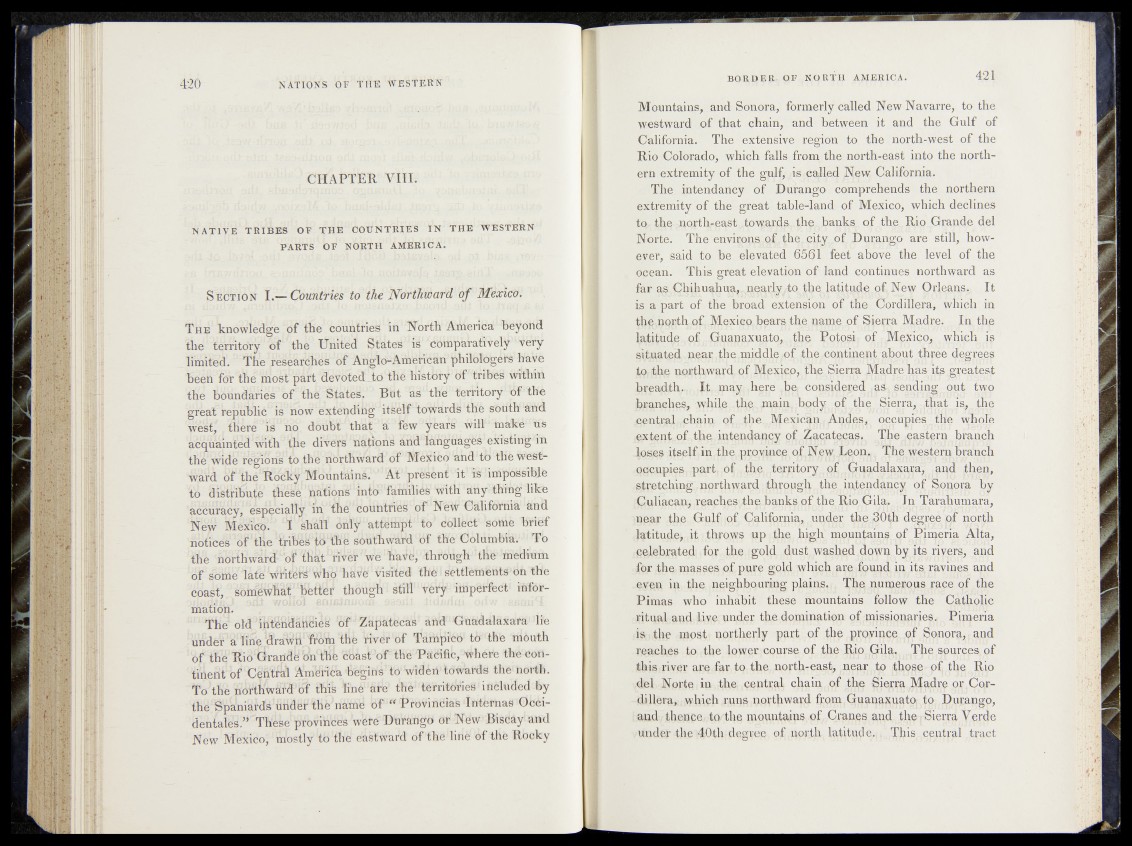
CHAPTER VIII.
NATIVE TRIBES OF THE COUNTRIES IN THE WESTERN
FARTS ' OF NORTH AMERICA.
Section I.— Countries to the Northward o f Mexico.
The knowledge of the countries in North America1,1 beyond.
tW °fqrritoTy of1 the United Stdte&'iS ëOhî^krafiVe^^e^y
limited. The jesearclies of Ah^o-Ameticàn ^»hilbîô^étè Wave
been f ^ tfië most part '^ë^jbfeïîid'tilié mètaiy3 t^ïribêS wfthhi
the b o u n ^ ë s 3'o rth rS ta të ^ .' Bdt a^W ^ ^m to rÿ foF ’thè
greçflf renüÜlic^ isJ no w1 extending .it£éff'To^rds1 thé sbtftWWhd.
wèslÇ rthereby0no dôüblf that“ âoe w 4eat§ $iffx inaiSVtië
acqülainteâ^wth^.&e divers naïuoÂs and Ia!h^^^®^exisiingxi1h.
thé e re^toilsfô.the northward of MeSft^RhdHb the Wëét-
Ward
tb âîstrièute thèse nâtiôn^ infto4Unâië&^ith: âriycthmg life
*^cmw^"esTOcigltjj: '^e"'hotfatfféS.';olPîfê^^âlif^iâaSiro.
io à ;e in o f i? e t^!)W^H'fe’p sbutWéVd‘Bf thé éôldmbfe^ Tb
the flbrtliw1ard^uof ïftht ^frféf f we 'ïradë, ' thrbiigh; tlie fiÿéd¥HMi
lW iomë 1 i^ JWife^wh¥ Laitë; Vi^tëd thé ! ^èttîèhiëhtsPëii Wb
oe a s l^ io ^ ^ â f l^ f e tté f thottgîi: ïfifbTmatioii.
11 3The olCiWè8ffl8ié^ W J1^pktkcüs\ âftidfnGtté!dàlaxaraj !lte
^ûWdêr^â'ïfhé ^rî^ttjTtë'Âi thé Vivéf‘bf Tànipïéb1 tèë'thte üièuth
% f-iW Ri3rffrartâfônTtllï éfesiPoTThë Bâëifië, Tthéfe thé con-
)t&ârl)f9D|Mffe % m ^ é h ^ M rtO'ViëértTbhhMë thé’horth.
To thé WdHMvSÿlï’t^F tÈfe mté**Sfte? tbèJ Territories rinèlnded-fey
thé'èpaiidWfitidëPïHPriéf&té bf ■" Ptovineiâfe dntètnas Gééi-
âehfcfés?* TW^Ie^tfevitélëS^whte'Déÿadgb ôî* ■Nëw* Biséây’and
New !MMéof ffisthf te f£W^ e^SÏttatd bf’thê^lirfé *ëf thë Rbcky
Mountains, .and Sonora, formerly called New Navarre, to the
westward of that chain, and between it and the Gulf of
California. The extensivetTe'^pn-, to the north-west of the
Rio Colorado, which falls from the north-east into the northern
extremity of the g^ft-^is^all|ed New California.
The intendancy, of Durango comprehends the northern
extremity of the great table-land? of Mexico, which declines
tcfc -j^~^eytl^-eastyE1pw^4^;ftfohal l ^ of Tim Rip Grande del
Norte. The e n v im l^ ^ th ^ c p v of, pqmito) are still, however,
said to be, elevated;»66j5i feetpabove the level of the
bpean. This great elevation of land ebhtinues 'northward .as
far Rs;pWhua]bua,„n^j^ito^t^eTatitude of Neiy Orleans® It
is a part of tne broad extension of the- Cordillera, which in
th^n^h^qft^qixiffbrjbpar&tl^ a a rn e ^ Sierra Madre, In the
l^tj|udgC( pj| g^uanaXimto,,. .the ^ptosi *• of r .Mexico, which,
mt-uatnd ...ne^r th e ip^ddle <qf tthe »continent about three degrees
to the npflt^ward, oCMexbx», fhe ^iprra Maarehas ite^reatesf
^reaifth^, .Th^iiaayf^here ;be conside*ed raTf sending out tv ||
branches, while the main body of the Sieyra, that is* the
^ n ^ jj^p h p in Q^Rjte., M exican And es, • bccupies the ymom
j^t^^C^ijth^int^p^apcy pf Zara,tecas» The ex te rn , brapch
New, Leon« t TIms Western branch
pgpupiea).jpaftj ‘o |fl t |^ terpitoryp m GuM,alaxMa| .and then,
s tre tchi n g ftgrtbpjanl; j^TWgb ft fhe~ Hitendaiiicw of Sonora by
ijG$lig|?aWi Rio Gila* _ f In Tarabumara,
gpaf the,.Gplf C^,iifc|rnia^ under we BOfln^^a^ree^M noi^i
latitude^ ,if ifhfOjW^ pp d ^ , ryg^ipo^Qj^ns- qf Pimeria Alta,
.ge^brated for 4hPdg°i^ dust washed dbwn.by^ its rivers, ajpH
for the? ipagaea |bf pnre apd
eyen in the .neigf^biQniing pjaips.,,, The,npmerniis race of the
Pimas who inhabit these mountains follow the Cjatholic
ritnaLandd^y*? th^^bffliwtibT1 Qf;ipj§fiQfiariea*,v Pinaeria
.iScuthf1 ino^ft bbfthprly part,, of fbe ,nrpjvince^,{<af£^)ppra^pand
re.acL^s to ,the lQwet*cp|jrs|!fpf. fhp WPn^il^h .«T^ie -seurcea pf
thisi ri-ypr ar.e, far, tp the, n p ft^ -^ ^ to dipse pf j f e . Rio
ji n , 9 j | p t f o j j f i i n , ^ pr.C«y-
•diUera,i! which .runs fnprthwar,d feam,Guanaxuata to Durango,
and/thenee^ffi/the |nqp^ifa^p^,pf//Qran^| and^thprSierrh ^erde
/and.ijr thel40th;degif^, of (npfifr tract